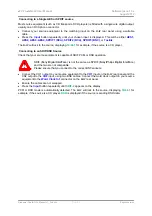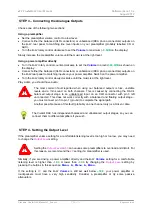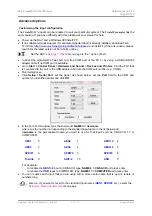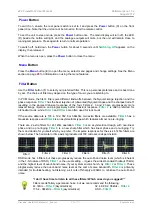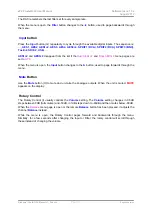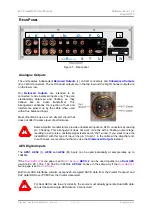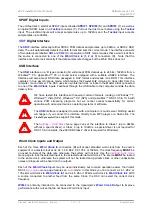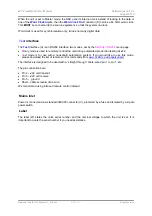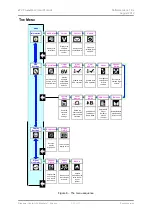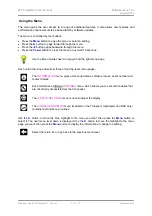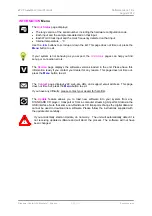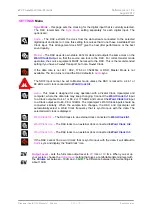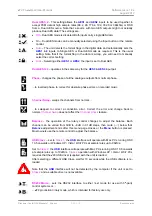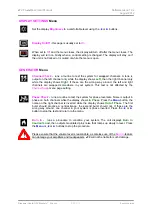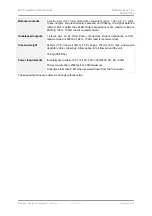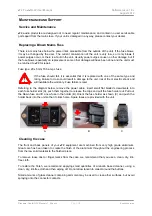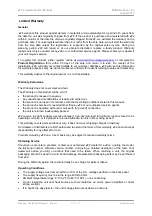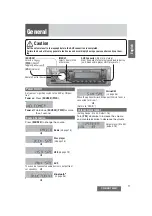
dCS Vivaldi DAC
User Manual
Software Issue 1.0x
August 2012
Filename: Vivaldi DAC Manual v1_0x.docx
Page 22
English
version
SPDIF Digital Inputs
The unit features 3 electrical SPDIF inputs, labelled
SPDIF1
,
SPDIF2
(N) and
SPDIF3
(T), as well as
an optical SPDIF input on a
Toslink
connector (P). Pull out the dust cover before using the
Toslink
input. The electrical inputs will accept sample rates up to 192kS/s and the
Toslink
input accepts
sample rates up to 96kS/s.
SDIF
Digital Interface
The
SDIF
interface will accept either SDIF-2 PCM data at sample rates up to 96kS/s, or SDIF-2 DSD
data. The unit automatically detects the data format and sets the correct mode. The interface consists
of two data inputs labelled
CH1
and
CH2
(O). Operation in SDIF mode requires that a word clock from
the source is connected to one of the
Word Clock In (1, 2 or 3)
connectors (R). Note that the
interface can fail to lock correctly if the data sample rate changes but the Word Clock does not.
USB Interface
The
USB
interface on a ‘B’ type connector (Q) will accept PCM data at up to 24 bits / 192kS/s from a
Windows™ PC, Apple Mac™ PC or sound server equipped with a suitable USB2.0 interface. The
interface will also accept DSD data packaged in DoP format and decode it as DSD. This interface
operates in true asynchronous mode, which makes the
Vivaldi DAC
immune to clock jitter from the
computer / sound server. The DAC uses its own internal clock or locks to the Master Clock connected
to one of the
Word Clock
inputs. Feedback through the USB cable to the computer controls the data
delivery rate.
!
We have tested this interface with several common formats running on Windows™ 7,
Windows™ Vista (SP2), Windows™ XP (SP3) and Apple Mac™ OSX 10.5 & 10.6 with
various PCM streaming programs but we cannot accept responsibility for correct
operation with all source devices, operating systems or software.
!
The
USB
interface is designed to work with a computer or sound server. Nothing useful
will happen if you connect the interface directly to an MP3 player or a flash stick. The
Vivaldi Upsampler
does support this mode.
!
The
Settings > USB Class
menu page can set the interface to Class 1 (up to 96kS/s
without a special driver) or Class 2 (up to 192kS/s, a special driver is not required for
OSX 10.6.3 onwards, the
dCS
USB Class 2 driver is required for Windows).
Word Clock Inputs and Output
Each of the three
Word Clock In
connectors (R) will accept standard word clock from the source
equipment or a master clock at 32, 44.1, 48, 88.2, 96, 176.4 or 192kHz. The clock frequency
MUST
be
an exact multiple of the data rate, otherwise the system will not lock. Use the
Settings>Sync mode
menu page to lock the selected input to the selected external word clock. The source
MUST
be locked
to the same clock, otherwise the system will not be locked and periodic clicks or other undesirable
noises or dropouts will be heard on the outputs.
Each of the
Word Clock In
puts may be used individually, but to make operation easier, the Vivaldi
DAC’s
Sync mode
menu page features an
Auto
mode. In this mode you can connect a 44.1, 88.2 or
176.4kHz word clock to
Word Clock In1
and a 48, 96 or 192kHz word clock to
Word Clock In2
. With
a source connected to another feed from the same Clock, the DAC can select the correct clock
frequency.
WClk3
is primarily intended to be connected to the Upsampler’s
Word Clock Out
put to improve
performance with sources that do not have a Word Clock input.


